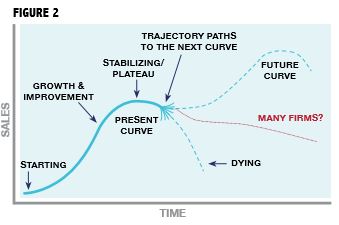The Relationship between Creativity, Innovation & Entrepreneurship
By DR. DAVID PRICE Professor of Marketing and Lecturer in Entrepreneurship at Washburn University
PART 4 of a 4-Part Series on Entrepreneurship The first two articles on entrepreneurship discussed the importance of creativity and innovation, and how these two concepts are different yet essential for any business. The third article focused on developing a sound business model, a framework of how the business will function and how it can be used for competitive advantage. This final installment will focus on an area that takes a business to the next level, from ordinary to extraordinary: growth.
professor 1
ACCORDING TO the Bureau of Labor Statistics, only 50 percent of all startup firms survive the first five years while a third survive for 10 years. Therefore, it makes sense that owners should question how to make their business profitable and sustainable, and the answer is to create and maintain an effective growth strategy.
Growing and expanding is an exciting time for any business. While reaching the breakeven point is a priority for a startup and often pure relief, growth can be exhilarating and a sign of real arrival in the marketplace. It is often signaled with a rapid rise in sales, hiring employees, larger facilities and greater market share. Whether a startup or an established business, growth should be a fundamental strategic goal.
THE GROWTH MYTH Generally, whether in business school or popular culture, we are taught that growth is good. While that belief is common, it is not necessarily true. A 1954 Time magazine article entitled “The New Magic Word in Industry” seems to have found its way into business folklore with an adage that businesses must “grow or die.” However, there is no science behind this claim. Many firms whether small, medium or large have continued operations while maintaining a similar size (based on number of employees and/ or sales) after many years, even decades. If firms sustain pace with inflation and their competitors, they can maintain the status quo for many years.
Additionally, many believe that growth is a simple linear function that climbs continuously upward at a steady pace. However, nothing could be further from the truth. Research suggests that this type of growth is the rare exception and not the rule, and it usually occurs when a company is scaling in its early stages, but it will eventually flatten out. Several studies point toward a far more complex pattern of growth, a pattern that is far more likely to represent a zigzag path, with many dips and plateaus.
As founders of high growth companies will attest, the growth model can represent a roller coaster ride, beginning with an initial upward rise (early stage scaling) and suddenly a takeoff in an instant – which unfortunately could up or down. To better understand these patterns, it is first useful to understand business life cycles.
professor 2
BUSINESS LIFE CYCLE As in life, businesses experience a birth, growth, maturity and decline. Figure 1 illustrates the classic life cycle of a business. This model also helps explain the early adoption of new products by consumers, where sales begin slowly and reach a point where they rapidly accelerate (early stage scaling) as new products are accepted in the marketplace at an exponential rate.
DECISIONS However, growth will slow down, and Figure 2 highlights this tipping point, where firms have reached the maturity phase. This may be for many reasons, such as market saturation due to an influx of competitors, environmental changes such as new technologies or a general lack of innovation. In either case, many firms in this phase begin to compete on price, and margins start to decrease. Firms must decide to either grow, stay with the status quo or face decline.
THE S-CURVE The S-curve is a term that is derived from mathematics; it is used in business to describe the performance of a company or a product over time. As seen in the Business Life Cycle, it has a characteristic slow and flat start with an eventual steeper upward trajectory that again begins to flatten out, and eventually declines, giving it the classic “S” shape.
professor 3
For startups and long-time business owners alike, its importance has to do with growth and sustainability. When a new company has hit a plateau or an established firm is finally tired of “just getting by,” a growth spurt can change the trajectory of the S-Curve so it trends upward once again. Importantly, firms should not wait to begin developing a growth strategy until they reach the maturity level. The growth stage is the time to start planning, as it will take time and resources for development that can lead to new growth. Many business owners know these concepts instinctively. Beyond hard data such as sales, they sense the market, the competitive environment and consumer preferences, and the direction the industry is leaning. As a result, their strategy and product offering may need updating.
The secret to sustained growth is in creating a series of new S-Curves. Owners and managers should have enough foresight to see over the peak of the curve and decide that change is necessary and the timing is right. Each business owner has experienced this, standing on the edge of a new opportunity, wondering whether the change involved is worth the additional work and risk, but knowing the payoffs could be substantial. Figure 3 shows the evolution of a growth-oriented business life cycle by creating S-Curves.
THE TROUBLE WITH GROWTH Many small businesses struggle to manage operational issues during a growth phase, and several issues must be considered when contemplating this option:
professor 5
Leadership - As a business owner, you should maintain a management role in the organization and hire enough help so that you may focus on management and strategy. Your ability to lead and manage falters as your work processes come under pressure from increasing demand. As the business grows, the founders should eventually transition to a leadership role, delegating most of the operational decisions and functions to someone else.
Systems and Procedures - Tied closely to leadership, a business needs systems and procedures for managing staff and providing the products or services of the company. Look at your daily business operations and determine what tasks can follow specific systems and procedures, and then get staff to buy in. Your employees will be key to successful growth, owners must delegate, make smart hiring decisions and keep them motivated.
Cash - Growth brings with it the need for more capital, and during the push for higher sales, monthly expenses will increase and possibly exceed your revenues. Cash flow can become a concern at this stage, and firms need a realistic plan that accounts for cash shortages due to delays in receivables or investments in growth. Prepare a backup plan for raising cash from personal sources, loans or a line of credit.
Customer Service Issues - If customer complaints are mounting, it may be an indication you are spread too thin, cutting corners to meet customer demand. If you feel overwhelmed, monitor your feedback and be as responsive as possible with customers. Keep an eye on real time outlets such as social media.
Job Satisfaction Decreases or Disappears - You may have started your own business so that you could set your own hours, be your own boss, and provide a product or service you are passionate about. One of the counterintuitive risks of growth is that your level of job satisfaction could significantly decrease. As a business grows, it changes. A small dynamic personal firm may become a very different organization, and owners must make a clear decision about what they want their business to be.
CONCLUSION Developing a growth strategy isn’t a one-size-fits-all process. You need to adapt your plan as you grow and understand that your organization is unique. My advice is to have a “work the gas pedal” approach to growth. Just like stressing an engine in a car by continuing to rev the engine, entrepreneurs should not continuously try to rev their operation. Just like engines, a business can only take so much stress, and growth will demand time, energy, resources, additional risk and personal sacrifice. Asking too much too quickly places a great deal of stress on you, your employees and the firm infrastructure. As you grow, there may be times when you need to back off the pedal, let yourself, your employees, manufacturing, partners and suppliers catch up and take a breath. Otherwise performance and quality may suffer.








